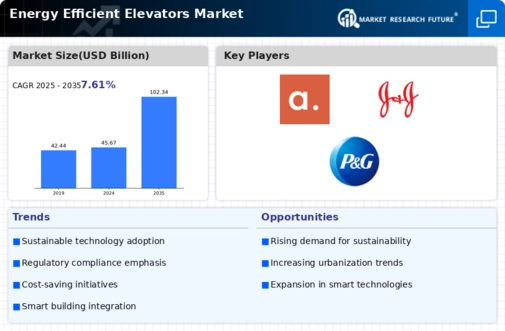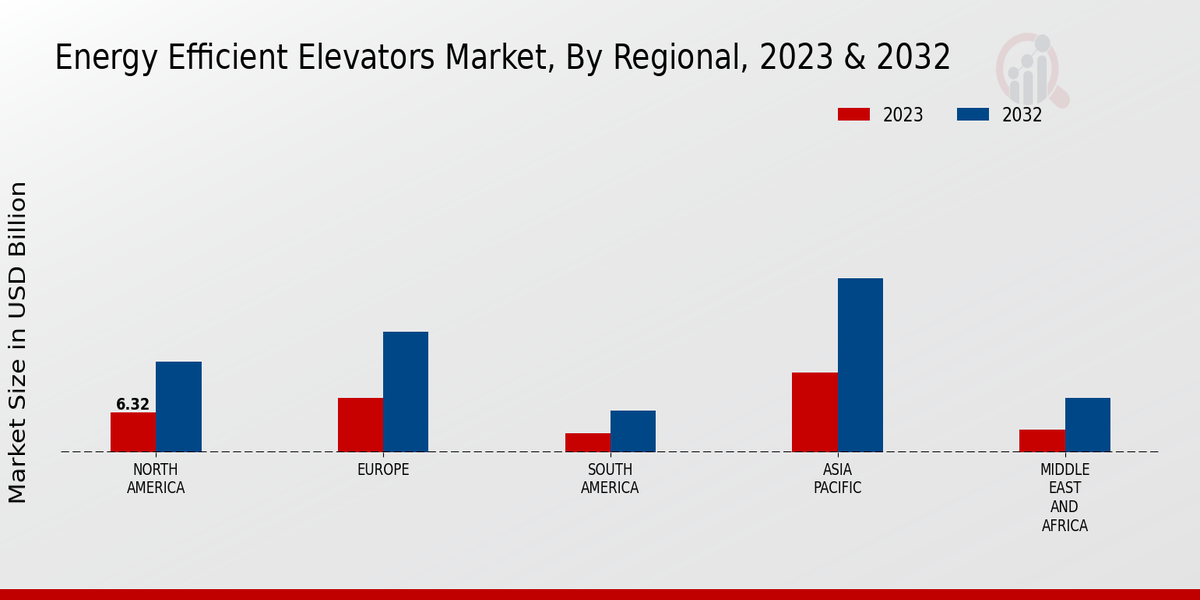Growing Urbanization
The rapid pace of urbanization globally is a primary driver for the Global Energy Efficient Elevators Market Industry. As cities expand, the demand for high-rise buildings increases, necessitating efficient vertical transportation solutions. In 2024, the market is valued at approximately 45.67 USD Billion, reflecting the need for energy-efficient systems that minimize operational costs and environmental impact. Urban areas are increasingly adopting green building standards, which often require the installation of energy-efficient elevators. This trend is likely to continue, as urban populations are projected to rise, further driving the demand for innovative elevator technologies.
Market Growth Projections
The Global Energy Efficient Elevators Market Industry is poised for substantial growth, with projections indicating a market value of 45.67 USD Billion in 2024 and an anticipated increase to 102.34 USD Billion by 2035. This growth trajectory suggests a robust demand for energy-efficient solutions, driven by factors such as urbanization, technological advancements, and regulatory support. The expected CAGR of 7.61% from 2025 to 2035 highlights the industry's potential for expansion, as stakeholders increasingly recognize the importance of energy efficiency in vertical transportation systems. This upward trend underscores the market's resilience and adaptability in meeting evolving consumer and regulatory demands.
Technological Advancements
Technological innovations play a crucial role in shaping the Global Energy Efficient Elevators Market Industry. The integration of smart technologies, such as IoT and AI, enhances elevator efficiency and user experience. For instance, predictive maintenance systems can reduce downtime and energy consumption, aligning with sustainability goals. As these technologies evolve, they are expected to contribute significantly to market growth. The anticipated CAGR of 7.61% from 2025 to 2035 indicates a robust shift towards smarter, more efficient elevator systems. Manufacturers are increasingly investing in R&D to develop advanced solutions that meet the growing demands of energy efficiency and user convenience.
Rising Construction Activities
The surge in construction activities worldwide is a vital driver for the Global Energy Efficient Elevators Market Industry. With urban development projects on the rise, there is a corresponding demand for elevators that offer energy efficiency and reliability. The construction of commercial and residential buildings often incorporates energy-efficient elevators as a standard feature. This trend is expected to persist, with the market projected to reach 102.34 USD Billion by 2035. The integration of energy-efficient systems in new constructions not only meets regulatory requirements but also appeals to environmentally conscious consumers, further propelling market growth.
Environmental Sustainability Initiatives
The increasing emphasis on environmental sustainability is a significant factor influencing the Global Energy Efficient Elevators Market Industry. As awareness of climate change grows, both consumers and businesses are prioritizing eco-friendly solutions. Energy-efficient elevators contribute to reduced carbon footprints and lower energy consumption, aligning with global sustainability goals. Many companies are adopting green certifications for their buildings, which often necessitate the use of energy-efficient elevators. This trend is likely to bolster market growth, as organizations seek to enhance their sustainability profiles while also benefiting from operational cost savings associated with energy-efficient technologies.
Regulatory Support for Energy Efficiency
Government regulations promoting energy efficiency are pivotal in driving the Global Energy Efficient Elevators Market Industry. Many countries are implementing stricter energy codes and standards, encouraging the adoption of energy-efficient technologies in buildings. For example, the European Union has established directives that mandate energy efficiency improvements in new constructions. This regulatory environment not only fosters innovation but also incentivizes building owners to invest in energy-efficient elevators. As a result, the market is expected to grow significantly, with projections indicating a rise to 102.34 USD Billion by 2035, driven by compliance with these regulations.














